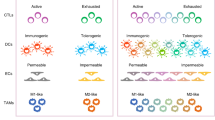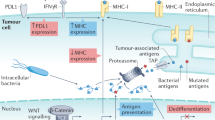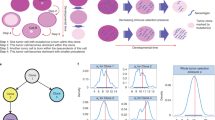Abstract
The dual properties of genetic instability and clonal expansion allow the development of a tumour to occur in a microevolutionary fashion. A broad range of pressures are exerted upon a tumour during neoplastic development. Such pressures are responsible for the selection of adaptations which provide a growth or survival advantage to the tumour. The nature of such selective pressures is implied in the phenotype of tumours that have undergone selection. We have reviewed a range of immunologically relevant adaptations that are frequently exhibited by common tumours. Many of these have the potential to function as mechanisms of immune response evasion by the tumour. Thus, such adaptations provide evidence for both the existence of immune surveillance, and the concept of immune selection in neoplastic development. This line of reasoning is supported by experimental evidence from murine models of immune involvement in neoplastic development. The process of immune selection has serious implications for the development of clinical immunotherapeutic strategies and our understanding of current in vivo models of tumour immunotherapy. © 2000 Cancer Research Campaign
Similar content being viewed by others
Article PDF
Change history
16 November 2011
This paper was modified 12 months after initial publication to switch to Creative Commons licence terms, as noted at publication
References
Ademmer K, Ebert M, Muller Ostermeyer F, Friess H, Buchler MW, Schubert W and Malfertheiner P (1998) Effector T lymphocyte subsets in human pancreatic cancer: detection of CD8(+) CD18(+) cells and CD8(+) CD103(+) cells by multi-epitope imaging. Clin Exp Immunol 112: 21–26
Agrawal B, Krantz MJ, Reddish MA and Longenecker BM (1998) Cancer-associated MUC1 mucin inhibits human T-cell proliferation, which is reversible by IL-2. Nat Med 4: 43–49
Aizawa K, Ueki K, Suzuki S, Yabusaki H, Kanda T, Nishimaki T, Suzuki T and Hatakeyama K (1999) Apoptosis and Bcl-2 expression in gastric carcinomas: Correlation with clinicopathological variables, p53 expression, cell proliferation and prognosis. International Journal of Oncology 14: 85–91
Alexandroff AB, Jackson AM, O’Donnell MA and James K (1999) BCG immunotherapy of bladder cancer: 20 years on. Lancet 353: 1689–1694
Bennett M, O’Connell J, O’Sullivan G, Roche D, Brady C, Kelly J, Collins J and Shanahan F (1999) Expression of Fas ligand by human gastric adenocarcinomas: a potential mechanism of immune escape in stomach cancer. Gut 44: 156–162
Berke G (1995) The CTLs kiss of death. Cell 81: 9–12
Boon T (1992) Toward a genetic analysis of tumor rejection antigens. Adv Cancer Res 58: 177–210
Cai ZZ, Bettaieb A, ElMahdani N, Legres LG, Stancou R, Masliah J and Chouaib S (1997) Alteration of the sphingomyelin/ceramide pathway is associated with resistance of human breast carcinoma MCF7 cells to tumor necrosis factor-alpha-mediated cytotoxicity. J Biol Chem 272: 6918–6926
Chen YT, Scanlan MJ, Sahin U, Tureci O, Gure AO, Tsang SL, Williamson B, Stockert E, Pfreundschuh M and Old LJ (1997) A testicular antigen aberrantly expressed in human cancers detected by autologous antibody screening. Proc Nat Acad Sci USA 94: 1914–1918
Cheng JH, Zhou T, Liu CD, Shapiro JP, Brauer MJ, Kiefer MC, Barr PJ and Mountz JD (1994) Protection from Fas-mediated apoptosis by a soluble form of the Fas molecule. Science 263: 1759–1762
Chouaib S, Asselin Paturel C, MamiChouaib F, Caignard A and Blay JY (1997) The host-tumor immune conflict: from immunosuppression to resistance and destruction. Immunol Today 18: 493–497
Christofori G and Semb H (1999) The role of the cell-adhesion molecule E-cadherin as a tumour-suppressor gene. Trends Biochem Sci 24: 73–76
Cox AL, Skipper J, Chen Y, Henderson RA, Darrow TL, Shabanowitz J, Engelhard VH, Hunt DF and Slingluff CL (1994) Identification of a peptide recognized by 5 melanoma-specific human cytotoxic T cell lines. Science 264: 716–719
Cromme FV, Vanbommel PFJ, Walboomers JMM, Gallee MPW, Stern PL, Kenemans P, Helmerhorst TJM, Stukart MJ and Meijer C (1994) Differences in MHC and TAP-1 expression in cervical cancer lymph node metastases as compared with the primary tumours. Br J Cancer 69: 1176–1181
Dawkins R (1988) The Blind Watchmaker Penguin: London
Driscoll J, Brown MG, Finley D and Monaco JJ (1993) MHC linked LMP gene products specifically alter peptidase activities of the proteasome. Nature 365: 262–264
Eder IE, Stenzl A, Hobisch A, Cronauer MV, Bartsch G and Klocker H (1997) Expression of transforming growth factors beta-1, beta 2 and beta 3 in human bladder carcinomas. Br J Cancer 75: 1753–1760
Engel AM, Svane IM, Rygaard J and Werdelin O (1997) MCA sarcomas induced in scid mice are more immunogenic than MCA sarcomas induced in congenic, immunocompetent mice. Scand J Immunol 45: 463–470
Fey MF and Tobler A (1996) Tumour heterogeneity and clonality – An old theme revisited. Ann Oncol 7: 121–128
Fuchs EJ and Matzinger P (1996) Is cancer dangerous to the immune system?. Semin Immunol 8: 271–280
Gallucci S, Lolkema M and Matzinger P (1999) Natural adjuvants: Endogenous activators of dendritic cells. Nat Med 5: 1249–1255
Garrido F, Cabrera T, Concha A, Glew S, Ruizcabello F and Stern PL (1993) Natural history of HLA expression during tumour development. Immunol Today 14: 491–499
Garrido F, Ruiz Cabello F, Cabrera T, Perez Villar JJ, Lopez Botet M, Duggan Keen M and Stern PL (1997) Implications for immunosurveillance of altered HLA class I phenotypes in human tumours. Immunol Today 18: 89–95
Gastl GA, Abrams JS, Nanus DM, Oosterkamp R, Silver J, Liu F, Chen M, Albino AP and Bander NH (1993) Interleukin-10 production by human carcinoma cell lines and its relationship to interleukin-6 expression. Int J Cancer 55: 96–101
Hahne M, Rimoldi D, Schroter M, Romero P, Schreier M, French LE, Schneider P, Bornand T, Fontana A, Lienard D, Cerottini JC and Tschopp J (1996) Melanoma cell expression of Fas(Apo-1/CD95) ligand: Implications for tumor immune escape. Science 274: 1363–1366
Hakansson L, Adell G, Boeryd B, Sjogren F and Sjodahl R (1997) Infiltration of mononuclear inflammatory cells into primary colorectal carcinomas: An immunohistological analysis. Br J Cancer 75: 374–380
Hu HM, Urba WJ and Fox BA (1998) Gene-modified tumor vaccine with therapeutic potential shifts tumor-specific T cell response from a type 2 to a type 1 cytokine profile. J Immunol 161: 3033–3041
Irmler M, Thome M, Hahne M, Schneider P, Hofmann B, Steiner V, Bodmer JL, Schroter M, Burns K, Mattmann C, Rimoldi D, French LE and Tschopp J (1997) Inhibition of death receptor signals by cellular FLIP. Nature 388: 190–195
Jackson AM, Alexandroff AB, Fleming D, Prescott S, Chisholm GD and James K (1994) Bacillus Calmette-Guerin (BCG) organisms directly alter the growth of bladder tumor cells. International Journal of Oncology 5: 697–703
Janeway CA, Goodnow CC and Medzhitov R (1996) Immunological tolerance – danger, pathogen on the premises. Curr Biol 6: 519–522
Jodo S, Kobayashi S, Nakajima Y, Matsunaga T, Nakayama N, Ogura N, Kayagaki N, Okumura K and Koike T (1998) Elevated serum levels of soluble Fas/APO-1 (CD95) in patients with hepatocellular carcinoma. Clin Exp Immunol 112: 166–171
Karecla PI, Green SJ, Bowden SJ, Coadwell J and Kilshaw PJ (1996) Identification of a binding site for integrin alpha E beta(7) in the N-terminal domain of E-cadherin. J Biol Chem 271: 30909–30915
Keating PJ, Cromme FV, Duggankeen M, Snijders PJF, Walboomers JMM, Hunter RD, Dyer PA and Stern PL (1995) Frequency of downregulation of individual HLA-A and HLA-B alleles in cervical carcinomas in relation to TAP-1 expression. Br J Cancer 72: 405–411
Kurokohchi K, Carrington M, Mann DL, Simonis TB, Alexander Miller MA, Feinstone SM, Akatsuka T and Berzofsky JA (1996) Expression of HLA class I molecules and the transporter associated with antigen processing in hepatocellular carcinoma. Hepatology 23: 1181–1188
Lanier LL (1998) NK cell receptors. Annu Rev Immunol 16: 359–393
Lee PP, Yee C, Savage PA, Fong L, Brockstedt D, Weber JS, Johnson D, Swetter S, Thompson J, Greenberg PD, Roederer M and Davis MM (1999) Characterization of circulating T cells specific for tumor-associated antigens in melanoma patients. Nat Med 5: 677–685
Lehmann F, Marchand M, Hainaut P, Pouillart P, Sastre X, Ikeda H, Boon T and Coulie PG (1995) Differences in the antigens recognized by cytolytic T cells on 2 successive mctastases of a melanoma patient are consistent with immune selection. Eur J Immunol 25: 340–347
Lengauer C, Kinzler KW and Vogelstein B (1998) Genetic instabilities in human cancers. Nature 396: 643–649
Ljunggren HG, Stam NJ, Ohlen C, Neefjes JJ, Hoglund P, Heemels MT, Bastin J, Schumacher TNM, Townsend A, Karre K and Ploegh HL (1990) Empty MHC class I molecules come out in the cold. Nature 346: 476–480
Maeda H and Shiraishi A (1996) TGF-beta contributes to the shift toward Th2-type responses through direct and IL-1O-mediated pathways in tumor-bearing mice. J Immunol 156: 73–78
Maeurer MJ, Gollin SM, Martin D, Swaney W, Bryant J, Castelli C, Robbins P, Parmiani G, Storkus WJ and Lotze MT (1996) Tumor escape from immune recognition – Lethal recurrent melanoma in a patient associated with downregulation of the peptide transporter protein TAP-1 and loss of expression of the immunodominant MART-1/Melan-A antigen. J Clin Invest 98: 1633–1641
Marzo AL, Lake RA, Lo D, Sherman L, McWilliam A, Nelson D, Robinson BWS and Scott B (1999) Tumor antigens are constitutively presented in the draining lymph nodes. J Immunol 162: 5838–5845
Matsuda M, Salazar F, Petersson M, Masucci G, Hansson J, Pisa P, Zhang QJ, Masucci MG and Kiessling R (1994) Interleukin-10 pretreatment protects target cells from tumor-specific and allo-specific cytotoxic T cells and downregulates HLA Class I expression. J Exp Med 180: 2371–2376
Medema JP, Toes REM, Scaffidi C, Zheng TS, Flavell RA, Melief CJM, Peter ME, Offringa R and Krammer PH (1997) Cleavage of FLICE (caspase-8) by granzyme B during cytotoxic T lymphocyte-induced apoptosis. Eur J Immunol 27: 3492–3498
Melcher A, Todryk S, Hardwick N, Ford M, Jacobson M and Vile RG (1998) Tumor immunogenicity is determined by the mechanism of cell death via induction of heat shock protein expression. Nat Med 4: 581–587
Morisaki T, Katano M, Ikubo A, Anan K, Nakamura M, Nakamura K, Sato H, Tanaka M and Torisu M (1996) Immunosuppressive cytokines (IL-10, TGF-beta) genes expression in human gastric carcinoma tissues. J Surg Oncol 63: 234–239
Multhoff G, Botzler C, Wiesnet M, Muller E, Meier T, Wilmanns W and Issels RD (1995) A stress inducible 72-Kda heat shock protein (Hsp72) is expressed on the surface of human tumour cells, but not on normal cells. Int J Cancer 61: 272–279
Niehans GA, Brunner T, Frizelle SP, Liston JC, Salerno CT, Knapp DJ, Green DR and Kratzke RA (1997) Human lung carcinomas express Fas ligand. Cancer Res 57: 1007–1012
Ochsenbein AF, Klenerman P, Karrer U, Ludewig B, Pericin M, Hengartner H and Zinkernagel RM (1999) Immune surveillance against a solid tumor fails because of immunological ignorance. Proc Natl Acad Sci USA 96: 2233–2238
O’Connell J, Bennett MW, O’Sullivan GC, Roche D, Kelly J, Collins JK and Shanahan F (1998) Fas ligand expression in primary colon adenocarcinomas: Evidence that the Fas counterattack is a prevalent mechanism of immune evasion in human colon cancer. J Pathol 186: 240–246
Pena JC, Thompson CB, Recant W, Vokes EE and Rudin CM (1999) Bcl-x(L) and Bcl-2 expression in squamous cell carcinoma of the head and neck. Cancer 85: 164–170
Pitti RM, Marsters SA, Lawrence DA, Roy M, Kischkel FC, Dowd P, Huang A, Donahue CJ, Sherwood SW, Baldwin DT, Godowski PJ, Wood WI, Gurney AL, Hillan KJ, Cohen RL, Goddard AD, Botstein D and Ashkenazi A (1998) Genomic amplification of a decoy receptor for Fas ligand in lung and colon cancer. Nature 396: 699–703
Poppas DP, Pavlovich CP, Folkman J, Voest EE, Chen XH, Luster AD and O’Donnell MA (1998) Intravesical bacille Calmette-Guerin induces the antiangiogenic chemokine interferon-inducible protein 10. Urology 52: 268–275
Restifo NP, Esquivel F, Kawakami Y, Yewdell JW, Mule JJ, Rosenberg SA and Bennink JR (1993) Identification of human cancers deficient in antigen processing. J Exp Med 177: 265–272
Romero P, Dunbar PR, Valmori D, Pittet M, Ogg GS, Rimoldi D, Chen JL, Lienard D, Cerottini JC and Cerundolo V (1998) Ex vivo staining of metastatic lymph nodes by class I major histocompatibility complex tetramers reveals high numbers of antigen-experienced tumor-specific cytolytic T lymphocytes. J Exp Med 188: 1641–1650
Rosenberg SA (1999) A new era for cancer immunotherapy based on the genes that encode cancer antigens. Immunity 10: 281–287
Sahin U, Tureci O, Schmitt H, Cochlovius B, Johannes T, Schmits R, Stenner F, Luo GR, Schobert I and Pfreundschuh M (1995) Human neoplasms elicit multiple specific immune responses in the autologous host. Proc Nat Acad Sci USA 92: 11810–11813
Seliger B, Hohne A, Knuth A, Bernhard H, Ehring B, Tampe R and Huber C 1996 a) Reduced membrane major histocompatibility complex class I density and stability in a subset of human renal cell carcinomas with low TAP and LMP expression. Clinical Cancer Research 2: 1427–1433
Seliger B, Hohne A, Knuth A, Bernhard H, Meyer T, Tampe R, Momburg F and Huber C 1996 b) Analysis of the major histocompatibility complex class I antigen presentation machinery in normal and malignant renal cells: Evidence for deficiencies associated with transformation and progression. Cancer Res 56: 1756–1760
Seliger B, Maeurer MJ and Ferrone S (1997) TAP off – Tumors on. Immunol Today 18: 292–299
Strand S, Hofmann WJ, Hug H, Muller M, Otto G, Strand D, Mariani SM, Stremmel W, Krammer PH and Galle PR (1996) Lymphocyte apoptosis induced by CD95 (Apo-1/Fas) ligand expressing tumor cells – a mechanism of immune evasion. Nat Med 2: 1361–1366
Svane IM, Engel AM, Nielsen MB, Ljunggren HG, Rygaard J and Werdelin O (1996) Chemically induced sarcomas from nude mice are more immunogenic than similar sarcomas from congenic normal mice. Eur J Immunol 26: 1844–1850
Taylor Papadimitriou J and Finn OJ (1997) Biology, biochemistry and immunology of carcinoma-associated mucins. Immunol Today 18: 105–107
Todryk S, Melcher AA, Hardwick N, Linardakis E, Bateman A, Colombo MP, Stoppacciaro A and Vile RG (1999) Heat shock protein 70 induced during tumor cell killing induces Th1 cytokines and targets immature dendritic cell precursors to enhance antigen uptake. J Immunol 163: 1398–1408
Torzewski M, Sarbia M, Heep H, Dutkowski P, Willers R and Gabbert HE (1998) Expression of Bcl-X-L, an antiapoptotic member of the Bcl-2 family, in esophageal squamous cell carcinoma. Clinical Cancer Research 4: 577–583
van de Welvankemenade E, Ligtenberg MJL, de Boer AJ, Buijs F, Vos HL, Melief CJM, Hilkens J and Figdor CG (1993) Episialin (MUC1) inhibits cytotoxic lymphocyte-target cell interaction. J Immunol 151: 767–776
Vanky F, Nagy N, Hising C, Sjovall K, Larson B and Klein E (1997) Human ex vivo carcinoma cells produce transforming growth factor beta and thereby can inhibit lymphocyte functions in vitro. Cancer Immunol Immunother 43: 317–323
Wick M, Dubey P, Koeppen H, Siegel CT, Fields PE, Chen LP, Bluestone JA and Schreiber H (1997) Antigenic cancer cells grow progressively in immune hosts without evidence for T cell exhaustion or systemic anergy. J Exp Med 186: 229–238
Yannelli JR, Hyatt C, McConnell S, Hines K, Jacknin L, Parker L, Sanders M and Rosenberg SA (1996) Growth of tumor-infiltrating lymphocytes from human solid cancers: Summary of a 5-year experience. Int J Cancer 65: 413–421
York IA and Rock KL (1996) Antigen processing and presentation by the class I major histocompatibility complex. Annu Rev Immunol 14: 369–396
Young DC (1989) Drug resistance: the clinical problem. Drug Resistance in Cancer Therapy Ozols RF (eds, pp 1–26, Kluwer: Dordrecht
Zhang K, Sikut R and Hansson GC (1997) A MUC1 mucin secreted from a colon carcinoma cell line inhibits target cell lysis by natural killer cells. Cell Immunol 176: 158–165
Author information
Authors and Affiliations
Rights and permissions
From twelve months after its original publication, this work is licensed under the Creative Commons Attribution-NonCommercial-Share Alike 3.0 Unported License. To view a copy of this license, visit http://creativecommons.org/licenses/by-nc-sa/3.0/
About this article
Cite this article
Pettit, S., Seymour, K., O'Flaherty, E. et al. Immune selection in neoplasia: towards a microevolutionary model of cancer development. Br J Cancer 82, 1900–1906 (2000). https://doi.org/10.1054/bjoc.2000.1206
Received:
Revised:
Accepted:
Published:
Issue date:
DOI: https://doi.org/10.1054/bjoc.2000.1206
Keywords
This article is cited by
-
Beeinflussung maligner Tumoren durch Anästhesieverfahren
Der Anaesthesist (2012)
-
Generation of MHC class I ligands in the secretory and vesicular pathways
Cellular and Molecular Life Sciences (2011)
-
Intracellular esterase activity in living cells may distinguish between metastatic and tumor-free lymph nodes
Clinical & Experimental Metastasis (2008)
-
Chemokines: novel targets for breast cancer metastasis
Cancer and Metastasis Reviews (2007)
-
Designing antibodies for oncology
Cancer and Metastasis Reviews (2005)



